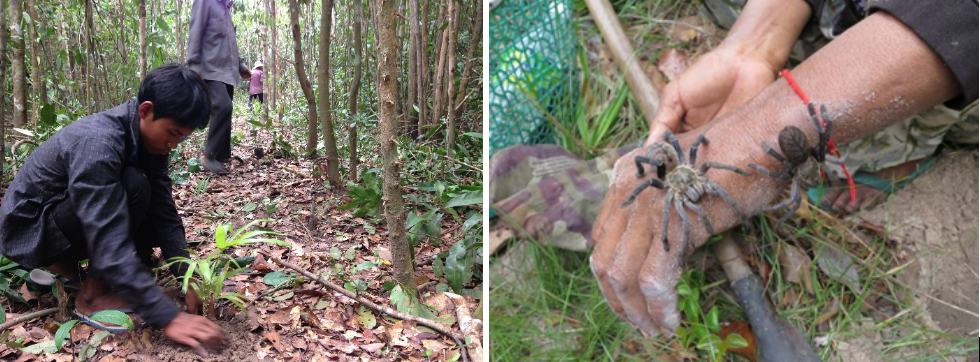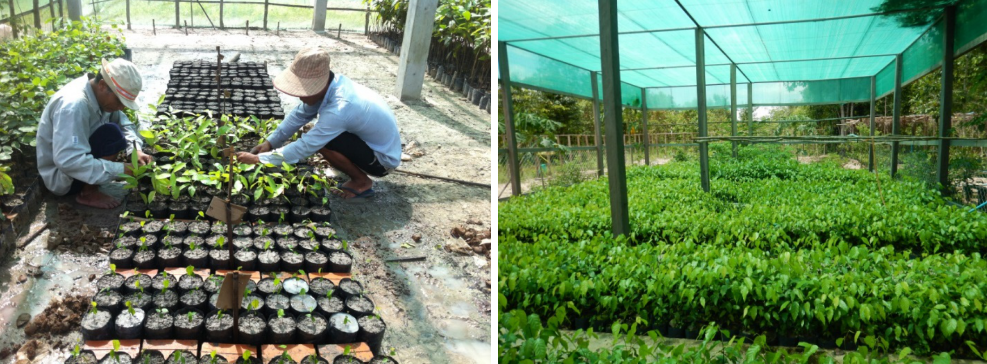Multi-Functional Forest Restoration and Management of Degraded Forest Areas in Cambodia
Project title: Multifunctional forest restoration and management of degraded forest areas [Project ID: 2011P4/KHM]
Supervisory agency: Ministry of Agriculture, Forestry and Fisheries
Executing agency: Institute of Forest and Wildlife Research and Development
Budget in USD (total/APFNet grant): 441,830/386,570
Duration: December 2011–December 2014
Target economy: Cambodia
Location: Siem Reap and Kampong Thom province
Objectives: Restore a degraded forest in Koh Kong province for environmental protection and biodiversity conservation; Enhance the restoration of a community forest in Siem Reap province for production of timber and non-timber forest products to improve livelihoods of local community.
Expected outputs: Community nursery established in each pilot site; Models of forest restoration plots established in each pilot site; Knowledge and experience on multifunctional forest restoration published and disseminated to relevant stakeholders and the general public.
Project background
One of the goals of community forestry is to rehabilitate forests. Rehabilitation is also a top priority for APFNet. In collaboration with the Forestry Administration of Cambodia, APFNet funded this project with the overarching aim to rehabilitate degraded forests and transform them into multifunctional healthy forests well-stocked with high-value timber species and non-timber forest products (NTFPs). In addition, the project sites will become recognized national models on forest rehabilitation and rural livelihood improvement. The project was conducted in two community forests, Prey Kbal Tik community forest, located in Tbeng Lech village; and O Soam community forest, located in Kampong Thom province, with the following two visions:
♦ O Soam community forest: A forest comprised of large diameter high-value timber species that support construction needs, with abundant NTFPs and creeks with fishes that support the livelihoods of the community.
♦ Prey Kbal Tik community forest: The forest is recovered and biodiversity restored so it can provide forest products for household use, income generation and support the ecotourism industry of the community.
Project featured topics
Restoring multifunctional forests tailored for each community
To increase forest cover in the past, the Community Forest Management Committee members and villagers applied traditional techniques to improve forest cover and health. However, the forests did not regrow quickly or well enough to decrease degradation substantially. From 2011 to 2014, with the support of the project, a forest restoration plan was produced to guide local communities on where and how to restore forests. New techniques such as silviculture, enrichment planting, assisted natural regeneration and agroforestry were applied to restore 50 ha of community forests (30 ha in O Soam and 20 ha in Prey Kbal Tik). Enrichment planting included over one thousand priority species in O Soam (15,718 seedlings) and Prey Kbal Tik (6,879 seedlings). Identified by the communities, the most important species included rattan, bamboo, fruit trees and high-value timber species. Some areas only required assisted natural regeneration to restore forest cover and health. Enrichment planting was identified as an appropriate restoration tool because plantings will not only increase forest cover, but also support community forest members’ livelihoods by providing construction material, poles for sale, food and a wide range of other NTFPs. For example, Mr Chhin Sath, a member in O Soam, collects mushrooms, wild fruits, fuelwood and spiders to sell to a local dealer from which he can earn about USD 75 per season.
 Figure 1. Community members plant rattan in the restoration plot (left); edible spiders collected by local community (right). Photos: Forestry Administration
Figure 1. Community members plant rattan in the restoration plot (left); edible spiders collected by local community (right). Photos: Forestry Administration
In addition, four 1-ha plots of degraded forests in each community forest (eight plots in total) were set aside for testing new forest restoration models, two plots in thinned forest areas and two plots in unthinned forest areas. Twenty seedlings were tagged for collecting data on height, diameter and other growth attributes to compare results from treated and non-treated plots over time. This will help identify and keep only the significant and most successful trees for future plantings.
Seedling propagation and supply
A community nursery and affiliated facilities have been established at each community forest to supply seedlings for their own needs and other regions or organizations. For instance, O Soam nursery was contracted to supply 3,600 seedlings of six species (including four fruit tree species) for a local Forestry Administration office in 2015. It is anticipated that contracts will be made every year, given the increasing need for trees by local Forestry Administration offices and non-governmental organizations. Community members and the local Forestry Administration office staff have learnt new skills in seed collection, seed pre-treatment and preparation of potting mixes as well as forest rehabilitation techniques. It can be proudly said that the two community forests have become hubs for local and international visitors, including other community forest members and university students, to learn about different models and techniques for the restoration of community forests. In the future, the local communities will be key catalysts to share knowledge about forest restoration throughout the country.
 Figure 2. Preparation of seedlings in the nursery and production of seedlings. Photo: Forestry Administration
Figure 2. Preparation of seedlings in the nursery and production of seedlings. Photo: Forestry Administration


